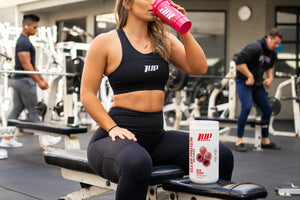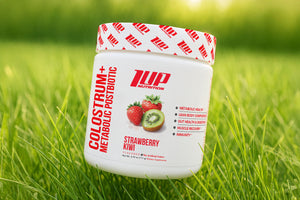Meal prep is a great way to save money, develop an important life skill, and stay on track with your nutrition plan and weight loss goals during your transformation challenge.
However, there are a number of stumbling blocks that you need to be aware of to make sure the food you buy and prepare is not only healthy, but safe to consume.
Here are 10 common food safety mistakes that individuals make and what you can do to ensure the food you cook is fresh, healthy, and safe!
#1 Letting Food Cool Before Refrigerating
This is a very common misconception (and practice) where individuals allow food to cool to room temperature on the counter (or in the cooking pan) before transferring it into storage containers.
However, waiting for hot food to cool at room temperature can increase the chance for illness-inducing microbes to develop (which none of us want).
Instead of waiting for your big batch of food to cool, divide it into smaller containers and transfer to the fridge.
#2 Putting Too Much Food in the Fridge at Once
Building off the previous point, while you do want to move your cooked food to the fridge relatively soon after it’s finished cooking, you don’t want to overload your refrigerator with food, particularly hot food.
The reason for this is that warm/hot foods and beverages will increase the internal temperature of your refrigerator, risking the possibility of food entering the “danger zone” temperature range where bacteria can start to grow and food will spoil.
A good rule of thumb is to leave enough room around each item in your refrigerator so that cold air can circulate freely, thereby keeping your food fit, fresh, and safe.
#3 Improperly Storing Groceries
Correct food storage, whether it be in the pantry, freezer, or fridge, is essential for safe food prep as well as maximizing the shelf-life of your groceries (which ultimately saves money!).
Raw proteins (meat, fish, eggs, etc.) should be stored in closed containers and separated from foods that you eat without cooking (e.g. yogurt, cheese, fruits, and certain veggies).
Freezer foods should be kept in tightly sealed packages to prevent freezer burn, and pantry staples (rice, pasta, oatmeal, etc.) should also be sealed to keep moisture and bacteria out.
#4 Ignoring Sell-By or Best-By Dates
This might seem fairly obvious, but you should be cognizant of when foods expire, especially raw proteins like beef, chicken, pork, and fish.
Every food and beverage you purchase (yep, even bottled water) has a best-by date. If you commonly find yourself throwing food away before using it by the sell-by date, try this grocery shopping hack -- grocery stores frequently place items that are expiring sooner at the front of the shelf and/or top of the pile. Therefore, if you’re looking for a longer shelf-life, consider digging to the back of the shelf or bottom of the pile.
#5 Leaving Groceries Out Too Long After Purchase
Just as you shouldn’t leave cooked food out on the counter too long after finishing meal prep, you also don’t want to wait too long to put your groceries in the fridge/freezer when returning home from the store.
Generally speaking, foods that need to be refrigerated or frozen should NOT be out at room temperature for >2 hours. This can lead to bacterial growth and spoilage.
#6 Not Washing Can Lids
This is one food-prep faux-pas that you probably didn’t even consider -- not washing the lids of canned foods before opening them.
While the food on the inside is safe, the outside of the can has been exposed to all sorts of bacteria and germs from leaving the packaging facility, to being placed on store shelves, to being touched by who knows how many individuals hands before making its way to your humble abode.
Therefore, before breaking out the can opener, rinse the top of the can with soap and water to minimize the risk of cross-contamination.
#7 Using the Same Cutting Board for Produce & Raw Meat
Many people use the same cutting board for all of their meal prep, but if raw meat is involved, then you want to use at least two cutting boards to prevent cross-contamination between the raw meats and the other foods that may or may not be cooked (fruits, cheeses, veggies, etc.).
One way to limit the risk of cross-contamination is to wash the cutting board with the raw meat residue as soon as you’re finished processing your proteins.
#8 Leaving Food in the Fridge Too Long
The Food & Drug Administration (FDA) advises only leaving cooked food in the fridge for 3-4 days. After that, it may not be safe to eat.
Big batches of food (soups, stews, whole chickens, etc.) quite frequently make more than 3-4 servings. In this case, store enough food for 3-4 days in the fridge and place the rest in freezer-safe containers in the freezer.
An exception to the 3-4 days is hard-boiled eggs, which will stay fresh in the fridge for up to a week.
#9 Malfunctioning Fridge/Freezer
Even if you have followed all of the other tips thus far, there’s still one other common food safety mistake you may not be aware of -- the temperature inside your fridge or freezer.
Sure, the temperature dial on the outside of your fridge might indicate that it’s cold enough, but are you certain that the gauge or indicator is working properly?
To make sure, buy a thermometer and leave one in your fridge and your freezer. The inside of your refrigerator should be below 40°F (4.4°C) and your freezer should be below 0°F (-18°C).
Also, remember that excessive opening and closing of the freezer and refrigerator can increase the temperature far above those deemed safe by the FDA. In other words, remember what your parents told -- don’t stand there with the door open!
#10 Improperly Storing Supplements
While the focus of this article has been on groceries, it’s also important to remember to store your supplements properly as well. Not closing supplement lids tight enough, leaving them in your car during the blistering months of summer, and allowing moisture into the product all can contribute to a faster expiration, reduced effectiveness/safety, and unpleasant user experience.
For example, a common practice is “dry-scooping” pre workout supplements. While it may look cool for the ‘gram, when a scooper touches your mouth, tiny particles of moisture can remain on the scooper, which then ends up back in your tub. This leads to clumping, and if enough moisture accumulates in your supplement tub, it’ll create a massive ball of goo that will be next-to-impossible to scoop and use.
This also goes for not screwing on the lids tight enough, especially if you live in humid environments.
As such, make sure to practice safe supplement storage just as you do with your groceries! Not only will you save money (as you won’t be throwing away tubs of clumpy pre-workout or essential amino acids), you’ll also get better results from your favorite products!






